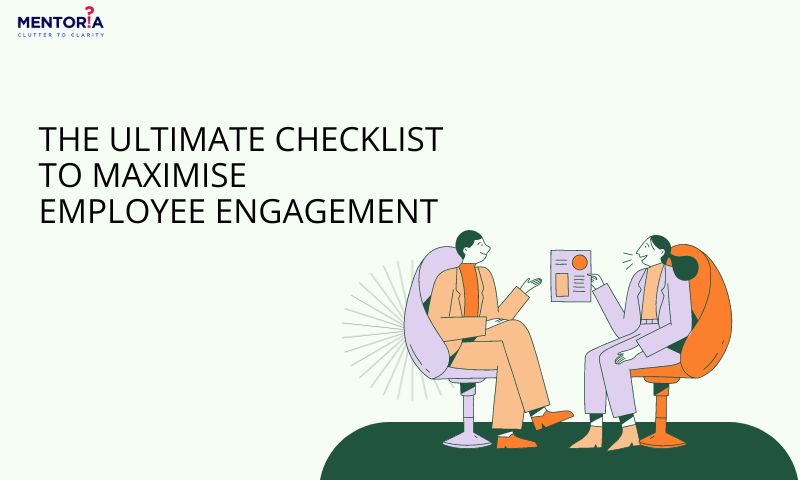The Ultimate Checklist To Maximise Employee Engagement

Jump to Section
You can trust your team. After all, they come every day. But are they limited only to completing tasks? Or are they emotionally and mentally invested in what they do and use their talents to the fullest? Ensuring employee engagement is crucial for the company’s prosperity, but it can be a challenge, especially during these unprecedented times of the pandemic when remote work has become the norm. That’s why managers have a vital responsibility in consistently working towards increasing employee motivation and engagement.
In this article, we will delve deeper into the concept of employee engagement, exploring its driving factors, significance, and distinguishing it from employee satisfaction. Additionally, we will provide you with effective strategies to enhance employee engagement within your organisation. Let’s get started
What Is Employee Engagement?
Employee engagement is the emotional responsibility that an employee has toward an organisation. Many people commonly confuse this commitment with employee happiness or employee satisfaction, and although they are close, it is not necessarily the correct definition. The definition is much more complex than that and requires a more complete view of an employee’s work life and work engagement.
Engagement comes from how well an employee’s personal goals and values align with the goals and values of an organisation.
Work environment → Employee commitment → Organisational goals → Own well-being
When an employee is engaged, they are not there for the money but because they care. They really want to see the company be successful and are willing to put in the effort without being asked.
What Statistics Say About Employees Engagement
One benefit of having engaged employees is that they will be more likely to provide good service to customers. This is what is known as the service-profit chain.
The service-profit chain is the link between service and profit. Profits come from customer loyalty while customer loyalty comes from their own satisfaction.
Here is the diagram:
Customer Satisfaction→ Customer Productivity→ Better Service→ Customer Loyalty→ Customer Satisfaction→ Profits
Here are some statistics that prove that engagement matters:
- 53% of people reported that they would stay with their current bosses if they felt they were more appreciated by them.
- It costs up to 10,000 to replace a good employee.
- Highly engaged workers are twice as likely to be top performers, and three-quarters of them exceed performance expectations.
- A 5-point improvement in employee attitudes leads to a 1.3-point increase in customer satisfaction.
- Banks categorised as “standard” found branches with a statistically significant increase in levels of engaged employees (0.2 or more on a scale of 5) had a higher profit margin growth of 16% more than branches with low levels of employee engagement. employees.
- A study of 64 organisations revealed that organisations with more engaged employees achieve twice the revenue of organisations in which employees lack engagement.
Engaged vs. Disengaged Employees
When talking about employee involvement, the terminology used differs depending on the classification groups used. For example, Gallup divides employees into three groups, based on their level of engagement:
Actively Engaged Employees
These are passionate and loyal employees who go above and beyond to help the company moves forward.
Uninvolved Employees
They meet work expectations but rarely do more than what is required or expected of them. They are not emotionally committed to their company and may actively seek other job opportunities.
Overtly Disengaged Employees
These employees are often negative or resentful of their company. They do the bare minimum in terms of productivity and quality of work.
Actively engaged employees provide a significant benefit to their company, not only because they increase productivity, but also because they are proactive and innovative in solving problems. Their enthusiasm is contagious and a source of inspiration for other team members. It can even extend to other services. Actively engaged employees are brand ambassadors who collaborate effectively, share knowledge, and develop positive relationships, within their company as well as with its partners and customers.
Decoding Job Happiness: Balancing Engagement And Satisfaction
On the one hand, employee satisfaction measures staff happiness. Employees may be satisfied with the pay and benefits, the company culture, and even the snacks you offer. However, employee motivation, their socio-emotional commitment, and their involvement at work cannot be measured in units of satisfaction.
On the other hand, employee commitment is what drives them to perform better. This is where you see your level of motivation and your commitment to work. Engaged employees know the business objectives and adapt their interests and values to them. If you have an effective strategy to boost employee engagement, staff are more likely to perform better and have a higher level of satisfaction.
Engaged Employees, Happy Workplace: The Winning Formula
This may seem obvious, but an actively engaged workforce brings several potential benefits. These benefits cover the company’s three main areas of improvement: business performance, customer satisfaction, and employee experience. Thus, successful companies place employee engagement among their top strategic priorities. Improving employee engagement has the following benefits:
Reduction In Absenteeism
Actively engaged employees don’t dread going to work and therefore don’t look for excuses to take time off. They play a role in the success of their company and are enthusiastic about promoting that success through continued work. This does not mean that they never take time off, just that these days off are not an attempt to escape their responsibilities.
Improved Retention
Training new employees takes time and costs money, and each member of your staff represents a significant investment. Involved employees are more interested in improving the company than in finding new job opportunities. They are loyal and much less likely to leave on a whim.
Happier, More Satisfied Employees
Although employee well-being and satisfaction do not necessarily lead to employee engagement, they are natural byproducts of it. The employees involved are satisfied with their work. They know that their strengths are recognised and that their work has value. Their superiors do not need to use threats or other types of negative reinforcement to force them to work.
Lower Risks For Employees
Employee engagement improves worker safety, despite being an often disregarded benefit. 70% fewer security incidents occur among highly engaged employees, according to Gallup. Engaged workers are also typically healthier and have lower rates of obesity and chronic illnesses.
Optimised Productivity
In other words, engaged employees get more work done. Better yet, because they take pride in their efforts and care about the impact of those efforts on the company as a whole, their work is of higher quality.
An increase In Turnover
The increase in turnover linked to employee involvement results from their increased productivity, but also from the reduction in costs associated with finding new talent, and from the positive impact that employees involved have on other team members and their work. Gallup indicates that highly engaged teams are 23% more profitable than disengaged teams.
Improved Customer Perception
Finally, engaged employees not only inspire their colleagues, they also have a positive impact on the people who run the business. They provide better service to customers while projecting a positive image of the company. This improves customer perception of your business and strengthens your brand reputation compared to other major brands in the market.
Workplace Wins: Simple And Effective Employee Engagement Strategies
There are many different strategies that companies can use to engage their employees that have been tested in organisations of all shapes and sizes around the world. From being able to clearly define your values to Recognising good staff and their work, there are strategies that employers around the world can use to develop their staff and get them engaged in their work.
Here are employee engagement strategies you can use in your organisation today:
Provide The Right Tools
One of the most effective ways to increase employee engagement is to ensure they have all the tools they need to do their jobs well. It can be very frustrating trying to accomplish a task without the right tools. It will take longer to do the work and it will be more difficult to achieve the desired results. This will cause frustration and make the employee miserable.
That’s why it’s important to ensure that employees have all the tools they need to be successful in their jobs. For example, accountants at your small organisation need the best accounting software to do their jobs effectively. Take a look at this Zoho Books review to see if it’s the right accounting tool for your business.
Improve Communication In The Organisation
One of the crucial things to keep in mind if you want to increase employee engagement within an organisation is communication.Communication is essential to the success of an organisation. It determines how colleagues relate to each other and accomplish their tasks. However, in many organisations, there is still a lack of communication between employees. This is probably because they continue to use outdated and ineffective channels to exchange information.
This hurts employee productivity as it makes it difficult for them to get the help they need to complete their tasks. It can also make them feel disconnected from their teams. To increase employee engagement, organisations must improve their communication methods with staff. In addition, it helps control business spending and reduce the company’s operating costs.
For example, if you have a hybrid or remote team, it’s helpful to use an internal communication tool like Slack to help your employees collaborate, regardless of their time zones.
Recognise Employees
Recognising your workers goes a long way toward making them feel valued and increasing their productivity. Rewards and recognition increase employee motivation and make them feel inspired to do their work. Ask them to promote your company using the right employee promotion software to curate and share the right content about your organisation on your social media accounts.
So, if you haven’t been doing so, you should incorporate employee recognition into your workplace management strategy to increase employee engagement.
Some effective ways to do this are
- Recognise your workers for their achievements in the workplace. Take note when a worker does something commendable and thank them for their good work.
- Celebrate your employees’ work anniversaries as a way to thank them for their loyalty to the organisation.
- Celebrate personal milestones like birthdays. A simple cake on an employee’s birthday will make them feel special.
- As you can see, none of these measures are expensive. These simple measures will help you create a positive work environment which, in turn, will boost employee morale and improve their well-being.
To make the recognition process even better, you can consider incorporating gamification into it. You can take advantage of employee engagement solutions that allow team members to reward their colleagues for their achievements. These rewards could add up to level-ups or accumulated points, which could then be exchanged for real gifts. It’s a great way to recognise employees and make them feel valued.
Invest In Your Workers
Another measure you can take to increase employee engagement is to provide your workers with relevant training and education. Employees want to be supported to do their jobs effectively, and organisations can do this by providing them with relevant training or study materials like this SEO hub. Of course, job-specific training is expensive, but what organisations get in return are qualified people with the skills necessary to perform their tasks well. This will increase employee productivity and help the organisation achieve its goals, resulting in a better return on investment.
Employees are also likely to stay with organisations that invest in them. Prepare employee development programs and offer them an opportunity for growth. This will help you retain your best employees as they will have no reason to seek employment elsewhere.
With employee training, workers do not have to take a leave of absence to attend classes. Most courses are now offered online, like this short accounting course that individuals can take during their free time.
Make Onboarding Seamless
Onboarding is a vital moment for workers to feel included from day one. It sets the tone for their time in your organisation and lays the foundation for employees to excel at their work.
A new employee may have all the skills necessary to do their job, but they still need to know how things work in your organisation. He needs to know who to turn to when he needs certain tools for a job. They have to know how to structure their reports after a job, etc. These things may seem insignificant, but they are important for new employees to settle into an organisation.
That’s why offering a seamless onboarding experience is crucial if you want to increase employee engagement. To do this, spend time showing new employees how things work in your organisation. For example, if you have a growing business, you need to show them how you will use email marketing tools, such as ConvertKit alternatives, to prepare the right email marketing strategy.
Invest In Team Building
As a business owner, your priority would be to generate greater revenue and drive business growth. But for best results, it’s important to invest in team building through events and meetings. Through team building events, you can create a special bond between your team members, allowing them to perform better and work cohesively.
It’s especially important for remote team members, who often end up feeling disconnected from the team because they don’t receive the same level of engagement as internal employees.15% of remote workers feel lonely and another 8% have difficulty collaborating with their colleagues. Organising online team-building sessions in such a situation can be a great way to improve employee bonding and engagement.
Improve Employees Well-Being
Investing in employee well-being is a great way to build engagement in the workplace, but it must be done practically. High engagement with low well-being results in other problems, such as burnout. This can be detrimental to organisations as staff who are unwell, and unable to do their jobs due to these issues, will impact the entire business.
Some of the practical ways to improve employee well-being include:
- Developing a healthy workplace
- Recognise the need for mental health awareness
- Develop a supportive business culture
- Offer discounts for gym memberships
- Bring in consulting dietitians and exercise therapists.
- Introduce regular office health sessions such as Yoga, Tai Chi (Chinese Martial Art Good for mental and physical health), or even group walks
- Introduce “duvet days”(A day that an organisation agrees employees can take off without advance notice) to help manage stress
Listen To Staff
Asking for employee feedback is an incredible way to build engagement, only if, however, you show that you are listening and taking action to make it happen. Firstly there should be a platform for staff to provide feedback and this can also be created to be done anonymously, the second step is to sit down with employees to review the feedback, create solutions, and discuss the issues. Technology for the first part can be a great tool to open communication channels. Some employees may feel uncomfortable discussing issues directly with managers or other employees present, this would promote a sense of broader participation and therefore commitment to the process from the beginning.
The second part is essential to curate better engagement with your employees. Nothing will frustrate and disengage your employees faster than if they feel like they are wasting their time sharing issues that are truly important to them. Organisations like Screwfix are known to have fortnightly feedback sessions with staff to discuss their opinions on almost everything. These discussions have promoted employee-driven initiatives that optimise the customer experience by keeping company conversations active and ongoing. According to Gallup, “those in the top quartile of engagement experience substantially better customer engagement, higher productivity, better retention, fewer accidents, and 21% higher profitability.”
Promote A Healthy And Pleasant Working Environment
The well-being of employees and their motivation are mainly based on a healthy working environment. For a corporate culture positive and focused on the happiness of your teams, don’t forget to remind them to take breaks regularly. Also, remember to watch for signs of stress and burnout, the number one enemies of employee motivation. In short, a good working environment promotes a healthy balance between private and professional life. For example, you can create a wellness committee within your company.
By combining these good practices with a strong sense of collaboration within teams and manager-employee communication, you will ensure that you offer a motivating and pleasant experience for all.
Encourage Taking Initiatives
To involve your employees in the life of the company, it is essential to show them that you value their autonomy and their ideas. Showing confidence in their work, focusing on macro-management, and encouraging decision-making and creativity are practices that promote professional development and employee motivation.
Certain tasks leave more room for innovation and creativity: they represent important opportunities to let your employees evolve in complete autonomy. With this in mind, we recommend that you give your employees the freedom to complete their projects on their own, with the tips and techniques that suit them, and to trust them throughout their journey.
The secret of healthy and constructive employee management lies in a good balance between the role of accompaniment and support, and an ability to leave room for initiative and accountability. Empowered employees are employees motivated to surpass themselves!
And What Else?
If budget allows, it can also be helpful to host annual team retreats where members of remote teams can connect in person. This helps them bond on topics other than work and helps drive organisational commitment. Many remote work companies like Toggl and Convert host these types of team retreats to help their employees bond and engage with each other.
Improve Employees Engagement With Mentoria
Finding ways to motivate, encourage, remain productive, and most importantly, be happy in your job, engagement strategies are an essential tool in today’s job market. It has become all too evident that while job satisfaction can be easily achieved through a few different strategies, keeping employees engaged is much more difficult but more essential and effective in reducing absenteeism, reducing turnover, and improving business results. and productivity.
Discover the path to a happy and meaningful life by unlocking your ideal career with Mentoria’s expert career coaches. Supercharge your professional growth with guidance tailored to your interests, personality, and abilities. Explore over 12,000 career options and find the one that suits you best. Learn how to make a practical switch to your ideal path with Mentoria’s career guidance. Your journey to a fulfilling career starts here.














